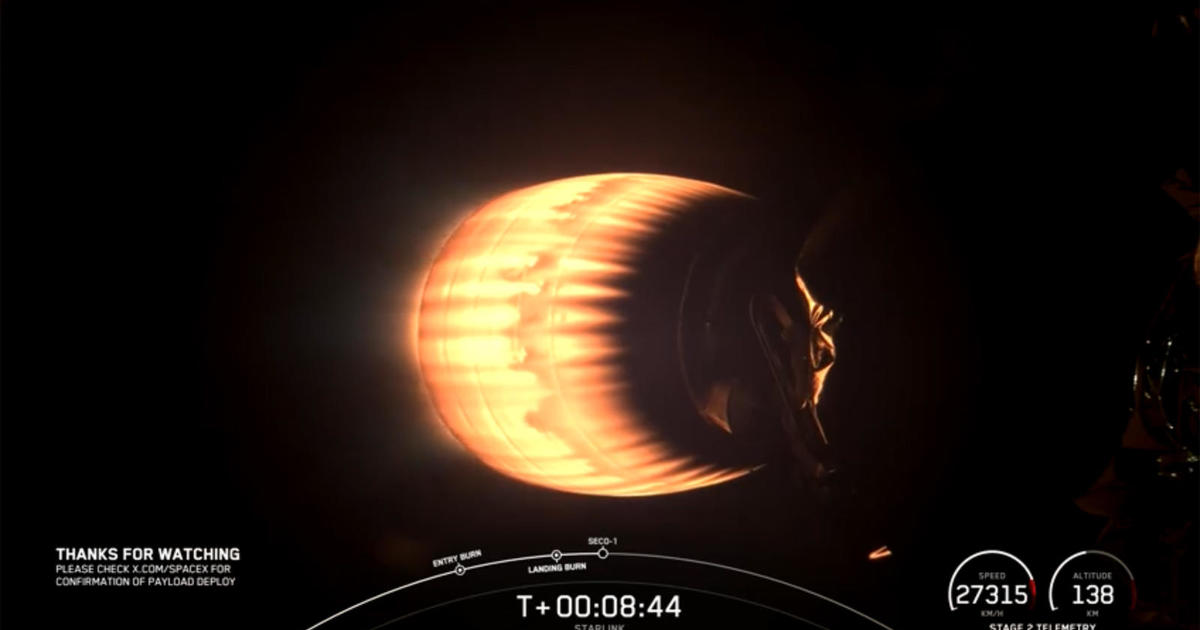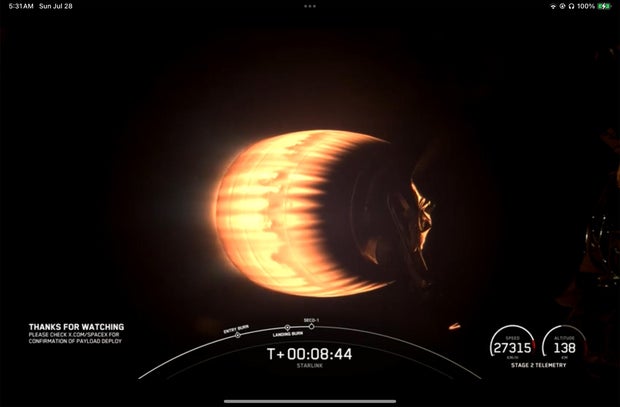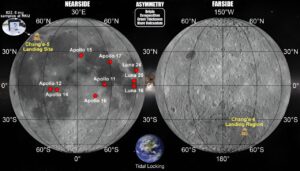SpaceX successfully launched three rapid-fire Falcon 9 rockets over the weekend, putting 67 Starlink satellites into orbit within three days after winning approval from the Federal Aviation Administration to resume launches following a rare in-flight failure on July 11.
SpaceX began its return to flight by launching 23 Starlink Internet satellites from the Kennedy Space Center early Saturday, followed by a second Starlink launch from the Cape Canaveral Space Force Station early Sunday that put 23 more broadband relay stations into orbit. The third Falcon 9 was launched a few hours later from Vandenberg Space Force Base in California.
All three flights appeared to take off without a hitch.
NASA is counting on Falcon 9s to launch a Northrop Grumman Cygnus supply ship to the International Space Station on Aug. 3, followed by a SpaceX Crew Dragon flight to carry three agency astronauts and a Russian cosmonaut to the lab around Aug. 18.
The second stage intended for use with the crewed flight, known as Crew 9, will be tested in the coming days at a SpaceX facility near McGregor, Texas, to verify that the company’s corrective actions will not have unintended consequences.
SpaceX
“It will undergo a second phase of hot fire around July 30, and that’s really to check some of the new modifications that this vehicle will have as a result of the anomaly,” said Steve Stich, commercial crew program manager of NASA. Friday.
“We’ve followed step by step this investigation that the FAA has done, SpaceX has been very transparent, we’ve involved our teams in the investigation and we’ve been following all the changes to this booster.”
The space agency has yet to officially approve those flights for launch, but SpaceX’s successful return to flight this weekend will no doubt play a role in the eventual decision.
Boeing engineers also had a busy weekend, successfully testing 27 maneuverable thrusters at the company The Starliner capsule is now docked with the International Space Station.
The tests confirmed the good performance of the Reaction Control System – RCS – thrusters, which had experienced problems earlier, and confirmed that known helium leaks in the capsule’s propulsion system had remained stable and had not worsened.
Tests show that the thrusters will function properly during the spacecraft’s eventual return to Earth.
“Single-pulse firings are designed to confirm the operation of each thruster,” Boeing wrote in an update. “Between each firing, the team reviewed the data in real time and all thrusters were operating at peak thrust values.
“The helium system also remained stable,” the company said. “Additionally, an RCS oxidizer isolation valve that was previously not fully seated was engaged several times during (Saturday’s) testing and is now operating normally.”
Launched June 5 on the spacecraft’s first manned test flight, the Starliner crew — commander Barry “Butch” Wilmore and copilot Sunita Williams — were originally expected to spend about eight days in space.
The mission has already lasted nearly two months due to work to fix problems with the thrusters and five helium leaks, one discovered before launch and four that developed during the capsule’s rendezvous with the space station.
NASA is expected to conduct a major review later this week to evaluate test data and determine the craft’s readiness to return Wilmore and Williams safely back to Earth.
William Harwood/CBS News
As for SpaceX and the Falcon 9, the company blamed the July 11 failure on a crack in an upper stage sensor line caused by a loose clamp and metal fatigue, which led to a leak of liquid oxygen.
The leak, in turn, caused extremely low temperatures in the engine’s water mains, slowing the flow of fluid needed to restart the power plant for a planned second burn.
Instead, the engine suffered a “hard start” that damaged multiple components, preventing the rocket from reaching its intended orbit. While the stage remained intact, the Starlinks it carried into space were launched into a much lower than planned orbit and subsequently burned up in the atmosphere.
Sarah Walker, a senior manager at SpaceX, said Friday that the “sensitive line” was not needed and would simply be removed from the rockets downstream. She said the data provided was available from other telemetry sources on the missile.
As for crewed Crew Dragon flights, she added, the second stage engine fires only once, and the leak that derailed the Starlink launch would not be a factor in a crewed flight. In any case, the fitting that has leaked will be removed.
“I’m extremely confident in the team, in the integrated approach that NASA is involved in the response,” said Nick Hague, Crew 9’s co-pilot and a veteran of the Russian Soyuz launch termination. “And I’m excited to get on the rocket when the team decides it’s time to go.”
He said the crew was training at SpaceX headquarters in Hawthorne, Calif., the day after the Starlink launch anomaly, “and from the beginning they engaged us in the conversation and told us everything they knew.”
The Federal Aviation Administration, which is responsible for licensing US launches, agreed with SpaceX’s analysis of the failure, concluding that “no public safety issues were involved.”
“This public safety decision means the Falcon 9 vehicle can return to flight operations while the overall investigation remains open, provided all other license requirements are met,” the FAA said in a statement.
Along with providing an update on SpaceX’s Falcon 9 short-term plans, Walker also addressed an unexpected problem with debris from Crew Dragon’s trunk sections that managed to survive the heat of re-entry to hit the ground.
The trunk section, equipped with solar cells, helps power the Crew Dragon in space and carries payloads from outer stations into orbit in a depressurized environment.
Before re-entry, the trunk is discarded. The crew capsule, equipped with a heat shield, then fires its brake rockets to exit orbit for a precision-guided drop into the ocean. The barrel continues into a low orbit and eventually makes an uncontrolled re-entry.
Early in the program, engineers concluded that the entire trunk would burn up completely during re-entry. But in a few cases, relatively large, charred pieces of trunk debris have survived entry to hit the ground.
Returning Crew Dragon astronauts and recently launched Dragon cargo ships returned to land off the coast of Florida, either in the Gulf of Mexico or in the Atlantic Ocean.
Walker said SpaceX now plans to move all cargo and Crew Dragon aircraft to the Pacific Ocean off the West Coast. Trunk sections will now be jettisoned after the rocket is launched from orbit, ensuring that they fall back into the atmosphere in roughly the same area as the crew and cargo pods, that is, well off shore.





